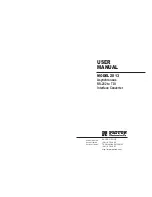
1-7
appropriate format and downloaded to the 2074 as waveform
coordinates. Dedicated waveform memory stores waveforms in
memory segments and allows playback of a selected waveform,
when required. The waveforms are backed up by batteries or can
be stored in a flash memory for use at a later time.
Frequency accuracy of the output waveform is determined by the
clock reference. Using the internal TCXO the reference oscillator
provides 1 ppm accuracy and stability over time and temperature. If
higher accuracy and/or stability are required, one may connect an
external reference oscillator to the rear panel input and use this
input as the reference for the 2074. Frequency may be is
programmed from the front panel with 11 digits of resolution and
with up to 14 digits from an external controller, so using an external
reference is recommended, if you intend to utilize the full resolution
provided by the instrument.
Output amplitude for each of the channels may be programmed
separately from 20 mV to 20 Vp-p into an open circuit, and 20 mV
to 10 V into 50
loads. Amplitude and offsets are completely
independent to each other and can be programmed with 4 digits of
resolution as long as the +5 V and the -5 V rail limitations (double
into open circuit) are not exceeded. The amplitude display is
calibrated to the load source, which is normally 50
. In cases
where the load difference is different, you can customize the
instrument to display the correct amplitude reading that matches
your load impedance.
Besides its normal continuous mode, the Model 2074 responds to a
variety of trigger sources. The output waveform may be gated,
triggered, or may generate a counted burst of waveforms. A built-in
re-trigger generator with a programmable period can be used as a
replacement of an external trigger source. Triggers can be delayed
to a specific interval by a built-in trigger delay generator that has a
range of 200 ns to over 20 seconds.
The arbitrary waveform memory is comprised of a bank of 16-bit
words. Each word represents a point on the horizontal waveform
scale. Each word has a horizontal address that can range from 0 to
2 Meg and a vertical address that can range from -32767 to +32768
(16 bits). Using a high speed clocking circuit, the digital contents of
the arbitrary waveform memory is extracted and routed to the
Digital to Analog Converter (DAC). The DAC converts the digital
data to an analog signal, and the output amplifier completes the
task by amplifying or attenuating the signal at the output connector.
There is no need to use the complete memory bank every time an
arbitrary waveform is generated. Waveform memory can be divided
into up to many smaller segments and different waveforms can be
loaded into each segment. The various segments may then be
loaded into a sequence table to generate long and complex
waveforms. The sequence table can link and loop up to multiple
segments in user defined order. Each channel has its own
sequence generator.
Содержание 5064
Страница 26: ...1 5 Figure 1 2 ArbConnection The Control Panels Figure 1 3 ArbConnection The Wave Composer...
Страница 71: ...2074 User Manual 2 18 This page intentionally left blank...
Страница 145: ...2074 User Manual 3 74 Figure 3 48 Reading the 2074 Internal Temperature...
Страница 207: ...2074 User Manual 4 62 Figure 4 47 Complete Pulse Train Design Figure 4 48 Section 5 of the Pulse Train Design...
Страница 220: ...4 ArbConnection Logging SCPI Commands 4 75 Figure 4 58 Log File Example...
Страница 221: ...2074 User Manual 4 76 This page was intentionally left blank...
Страница 333: ...2074 User Manual 7 2...
Страница 358: ...7 Adjustments and Firmware Update Updating 2074 Firmware 7 27 Figure 7 9 Firmware Update Completed...
Страница 359: ...2074 User Manual 7 28 This page was intentionally left blank...
Страница 360: ...Appendices Appendix Title Page A Specifications A 1 1...
Страница 361: ...2074 User Manual 2...
















































